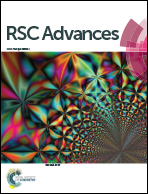Superior white light emission and color tunability of tri-doped YBO3:Tb3+, Eu3+ and Dy3+ for white light emitting diodes†
Abstract
A tri-doped YBO3:Tb3+, Eu3+ and Dy3+ phosphor, which is capable of producing white light by combining blue, green, yellow, orange and red emissions when excited at 365 nm ultraviolet (UV) light, was developed using a general hydrothermal method. The samples showed strong photoluminescence spectra at 485, 541, 578, 591, 611, and 627 nm under the excitation wavelength of 365 nm (ultraviolet light) indicating the presence of blue, green, yellow, orange and red light due to the transitions 4F9/2 → 6H15/2 (Dy3+), 5D4 → 7F5 (Tb3+), 4F9/2 → 6H13/2 (Dy3+), 5D0 → 7F1 (Eu3+) and 5D0 → 7F2 (Eu3+), respectively. Tri-doping is seemed to be more successful in the creation of white light. The effect of the variations in doping percentages on color tunability was also evident. Evidence of efficient energy transfers from the host excitations to activators Tb3+ and Eu3+, and from Dy3+ to Tb3+ to Eu3+ existed. Although there is a weak energy transfer from host to Dy3+ occurred, strong photoluminescence excitation bands existed in Dy3+.


 Please wait while we load your content...
Please wait while we load your content...